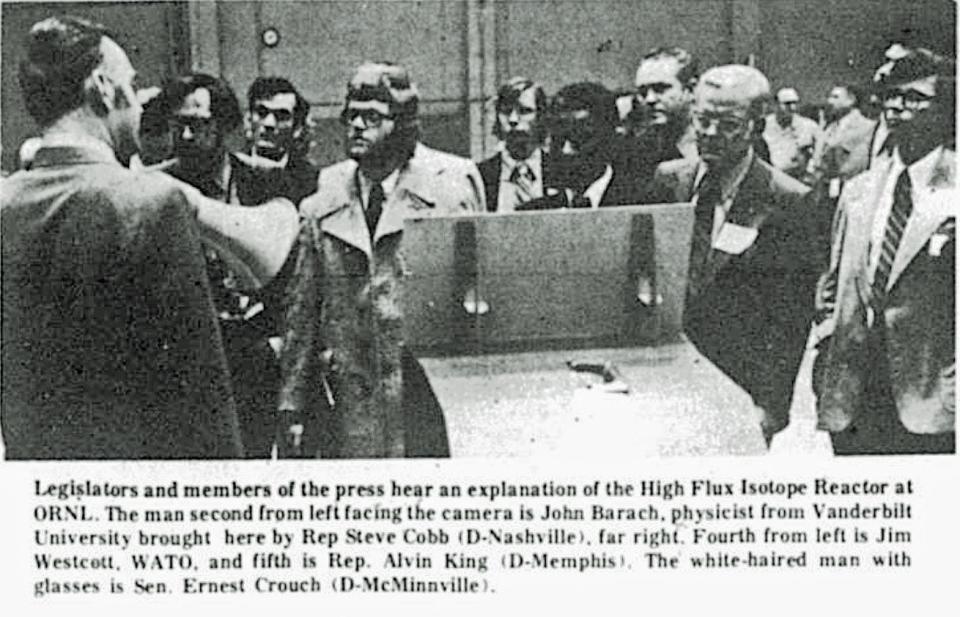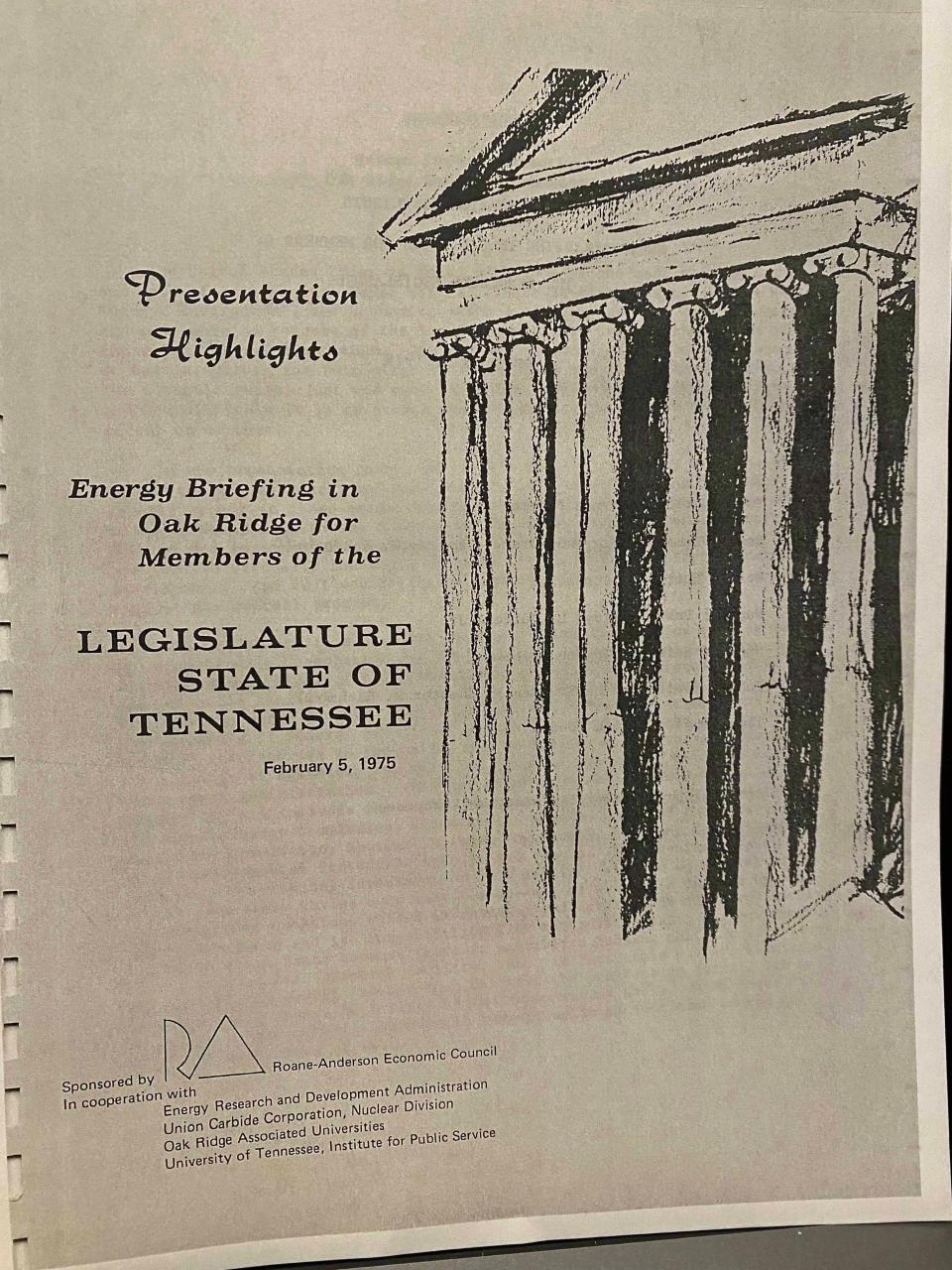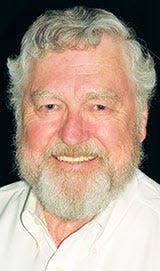Tennessee Legislature met in Oak Ridge in 1975
- Oops!Something went wrong.Please try again later.
In February of 1975 the Tennessee State Legislature met in a special session in Oak Ridge at the old Holiday Inn located on Illinois Avenue. Approximately 90 members, from across the state, led by House Speaker Ned Ray McWherter, convened to discuss nuclear energy and the impact of Oak Ridge on the economy of the state.

This event was brought to my attention by Gordon Fee, who brought me a folder labeled, “Presentation Highlights” and said, “You should write about this in 'Historically Speaking'.” As I am always glad to have suggested topics for "Historically Speaking," I said, “Sure.”

When I later looked at the materials, it consisted of the copies of the actual viewgraphs used by the speakers and the text of their talks. Wow, I was anxious to get going, but wait, nothing was said in those materials about the event itself.
My first thought was to go to the internet looking at the Tennessee General Assembly webpage, but there was no mention of a Feb. 5, 1975, meeting at all. I did learn that in 1975, “a new house cost $39,300, a new car was $4,225, a movie ticket was $2, a gallon of gas was 44 cents, and a postage stamp was 13 cents”. Well, that was depressing!

I tried OSTI.gov … nothing. So, at Gordon’s suggestion, I tried The Oak Ridger by asking Mike Stallo, our reference librarian and historian at the Oak Ridge Room of the Oak Ridge Public Library. I am proud of Mike’s work at the Oak Ridge Room. Have you seen it lately? It has been expanded significantly; you should check it out!
Mike turned up much information there, some of it written by Carolyn Krause! Mike kindly scanned some pages for me. So here is what I found out.
The Roane Anderson Economic Council in cooperation with Energy Research and Development Administration, Union Carbide Corp., Nuclear Division, Oak Ridge Associated Universities, and the University of Tennessee, Institute for Public Service, were the sponsors of the event. The featured speakers were Herman Postma, director of Oak Ridge National Laboratory, Murray Rosenthal, associate director for ORNL Advanced Energy Systems, Floyd Culler, ORNL deputy director, Gordon Fee, director for ORNL Reactor Division, and Chester Richmond, associate director for ORNL Biomedical and Environmental Sciences.
The event was labeled, “Energy Briefing in Oak Ridge for Members of the Legislature State of Tennessee.” The opening statement by Postma began with, “The United States today is faced with some of the most complex issues and sets of crises since World War II. These involve primarily three E’s - Energy, Environment, and Economics – each a complex issue in and of itself and made more so because of the interdependent and interacting nature of the relationships among them. Our current national efforts to simultaneously do battle against the twin plagues of inflation and recession provides in the economic realm, just one example of the complexity of these problems and how difficult it is to attack the one without having an adverse or intended effort on another.”
Does that strike you as a statement that could as well be made today? We are still in the same battles. I find doing this research that many such similarities exist between 2023 and 1975.
Postma went on to say that the focus of this briefing was on energy and environment. He described ORNL as transitioning from an “atomic laboratory” to missions that, “now involve virtually the whole spectrum of the nation’s energy research and development.” He was proud to note that the lab was doing $134 million worth of work (the ORNL budget today is over $2 billion, with over half that coming from the Department of Energy’s Office of Science, and Y-12’s budget is also over $2 billion.). ORNL had 4,500 employees in 1975 (ORNL’s number of employees is approximately 6,000 today and Y-12 is approximately 7,800).
The intent of the briefing was stated as being focused on nuclear energy rather than on other energy sources or conservation. The reason given was “because much public attention is being paid to it, because it is an announced major element in the policy of striving toward self-sufficiency, and because it is why you are here. Presently, it is in the field of nuclear energy that most of the emotions, most of the divergent expert opinion, and most of the rhetoric arise. Through our presentations here we will aim to provide as coherent a picture of the overall situation as we can,” Postma concluded in his opening remarks.
Playhouse director hired to help with presentation
An interesting side note to this whole affair is that realizing the potential difficulties of discussing scientific material with non-scientists, the senior management of Union Carbide hired Paul Ebert, Oak Ridge Playhouse director, to help stage the event and critique the speaker’s presentation. Several members of the League of Women Voters also attended dry runs of the presentations to help assure non-technical individuals could easily understand what was being presented.
Gordon commented that not all the speakers appreciated the thought that they might “talk above the heads” of the legislators, but agreed to listen to input on how they might be sure they were not using scientific language that would not be easily understood. After the event was over, all the speakers were complimentary of the help that Paul had provided, and his input had made it a great event
Ben Adams, one of the main drivers of this initiative, along with Eugene "Gene" Joyce, said he thought it was important to note how well all segments of the Oak Ridge community joined forces to help make this unique session of the Tennessee General Assembly successful. All news reports agreed this was a most successful event. It is hard to measure the results. However, Oak Ridge was and still is a key element in the state’s energy solutions, a strong economic force for the state, and remains prominent in our nation’s defense and energy-related research and development, as well as many other scientific fields of discovery impacting the world.
In addition to presentations, a panel discussion was led John H. Gibbons, director of University of Tennessee Environment Center, four tours were provided, and an evening reception was held at the American Museum of Atomic Energy. It was in the new location on Tulane Avenue as the museum had moved from the Jefferson Avenue location in 1975. The museum did not change the name to the American Museum of Science and Energy until 1978. This is a hint that some things happened in the 1970s and Oak Ridge tried to respond. A mistake I believe as it was then that “nuclear” fell out of favor for us as well. Sad. I am glad to see we are now once again proud to be associated with “atomic” and “nuclear.”
The tours included two of the ORNL locations at the Y-12 Plant in Building 9201-2 (Alpha 2) where John Clarke, division director, showed them the ORMAK, what was then the most powerful heating experiment in the world - a doughnut-shaped research machine based on the Russian tokamak concept. The experiment contained hydrogen gas plasma heated to 20 million degrees in an early stage of fusion energy research.
You readers know I like to explain acronyms when I can. The best I can do with ORMAK is to say I think it stood for Oak Ridge tokaMAK.
Preserve history now
In researching this event I want to remind everyone how important it is to be sure we are preserving historic artifacts such as the ORMAK and even the cyclotron located in the basement of Alpha 2. The Large Coil Test Facility in Building 9204-1 (Beta 1) is another and of course, the Manhattan Project National Historical Park’s Building 9204-3 (Beta 3), our single remaining building with Beta Calutron racetracks intact and most certainly worthy of a National Historic Landmark distinction.
And there are many more artifacts of the Nuclear Age after the Manhattan Project that are being lost regularly as buildings are demolished. We must not quit with the Manhattan Project era. The history of the Cold War era and the Nuclear Age is virtually important for future generations just as the very important Manhattan Project era was and still is. Encourage the preservation of the history of these eras as well. Once the artifacts are gone, the memories are soon gone as well. Video and photos can do so much, but actual authentic artifacts are irreplaceable.
The Friends of the Oak Ridge Public Library recently received a donation from Major General Leslie Nichols' niece to start an initiative to capture Oak Ridge-related historical information in known central locations such as the museums and the library’s Oak Ridge Room. She had difficulty locating information about Nichols time in Oak Ridge and wanted to encourage us to do a better job of capturing information that might otherwise be lost. We are grateful to the Nichols' family for helping us preserve the history of Oak Ridge.
If you have materials from your parents or grandparents that you would like to see preserved, contact the Oak Ridge Public Library’s Oak Ridge Room, Mike Stallo. He will either archive the material or will see if any of the museums can do so. We are losing too much historical information and must do a better job.
I will continue the history of this unique event in the next addition of "Historically Speaking" and describe the tours of Oak Ridge in which the legislators were engaged.

This article originally appeared on Oakridger: Tennessee Legislature met in Oak Ridge in 1975

